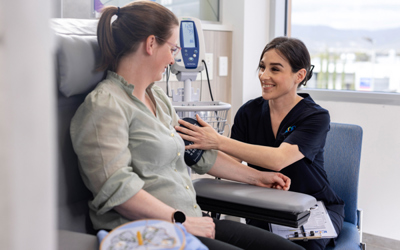Quick facts about bladder cancer
Bladder cancer is more common in men than women and is one of the ten most common cancers diagnosed in Australian men
The likelihood of bladder cancer developing in people aged up to 85 years is one in 97 (or 1%)
The five year survival rate after having bladder cancer is 55%
Types of bladder cancer
The bladder is a muscular balloon-shaped organ that can expand and contract (get smaller) depending on how much urine is in the bladder.
The bladder is made up of four layers of tissue. The tissue that your cancer develops in helps determine the type of bladder cancer you have:
-
Urothelium
The urothelium consists of cells that keep the urine in the bladder and prevent it being absorbed into the body. It is the first layer inside of the bladder.
-
Lamina propria
The lamina propria is next to the urothelium layer and consists of blood vessels.
-
Muscularis propria
The muscularis propria is the thickest of all layers and is responsible for contracting the bladder to empty urine.
-
Perivesical tissue
The perivesical tissue surrounds all other layers of the bladder and consists mainly of fatty tissue to help protect the bladder.
Signs and symptoms of bladder cancer
As signs and symptoms for bladder cancer can be similar to other conditions, it’s important to see your GP or healthcare professional if you experience any of the symptoms below. Discussing anything concerning as soon as possible can help give you peace of mind and offer the best chance of successful treatment if you receive a bladder cancer diagnosis.
Symptoms can include:

Blood in urine
This can be in small amounts and may be brownish or red in colour. It tends to come on quickly, and can come and go

Changes in urination
Such as feeling the need to urinate more often or pain (such as a burning sensation) when urinating

Pain in the pelvis or lower back
Usually on one side

Weight loss or bone pain
If the cancer is advanced
Stages of bladder cancer
The TNM system is used to stage bladder cancer and define what your cancer looks like. The TNM stands for:
Tumour – the depth of invasion through bladder wall
Node – is a measure of whether lymph nodes have been affected
Metastasis – the degree to which the cancer has spread to other organs of the body
The TNM information, along with other tests, helps determine the stage of your bladder cancer using the guidelines below. A biopsy of the tumour will also provide information to help your doctors ‘grade’ your cancer. This takes into account how quickly it will grow and the chance of it coming back.
-
Low grade
Most tumours in the bladder are considered low grade, which means the cancer cells are slow growing and do not tend to spread and look like bladder cells
-
High grade
These cancer cells look very different to bladder cells and tend to grow quickly and spread to other tissues in the body
Treatment for bladder cancer
There are many different types of treatment for bladder cancer. Your treatment will depend on you and your cancer.




